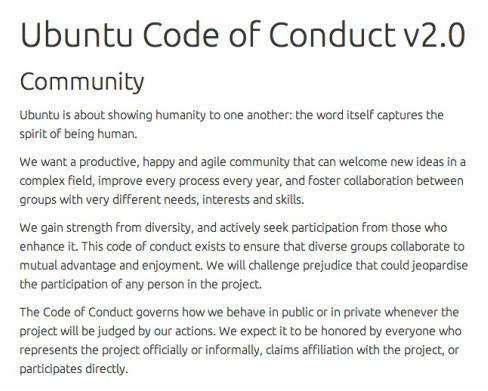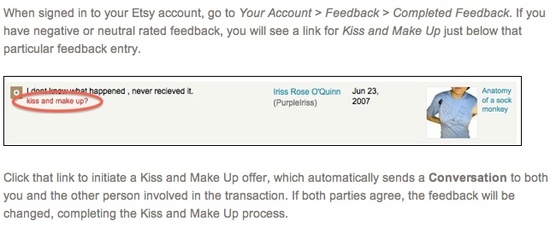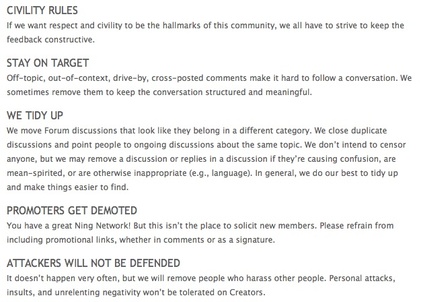This post originally appeared on Musings of a Galvanizer.
—
 Joining a new online community can feel like attending a party at a new friend’s house. The Community Manager acts as a welcoming host: sharing event details in the invites, introducing guests to one another during the party, letting people know if it’s cool to dance on the tables. (Always encouraged at my place.)
Joining a new online community can feel like attending a party at a new friend’s house. The Community Manager acts as a welcoming host: sharing event details in the invites, introducing guests to one another during the party, letting people know if it’s cool to dance on the tables. (Always encouraged at my place.)
Bringing people together, offline or online, is best pulled off with a simple code of conduct. These set clear expectations for participants and provide a plan of action if things go south. I’d recommend drafting these right from inception; hunker down with your CEO, Product Manager, and head of Customer Support to brainstorm. Then pass the final draft by legal. Let the checklist below be your guide!
For those of you in later stage companies with community flywheels already turning, you may notice a rash of users acting up. This typically happens during periods of rapid growth when new participants have less contact with the company and exemplary community members, or when people get creative and use your product for an unintended purpose. (Sometimes this can be awesome, other times, detrimental.) In either case, it’s time to update your Code of Conduct to reflect this new behavior.
Here are the 6 boxes to check:
Voice
Ethos
Identity & Reputation
Communication
Disputes
Violations
Let’s dig in to each one and check out a few examples from Etsy, Ubuntu, Airbnb, and more.
1. Voice – Set the tone
Who are you speaking to? Your voice should reflect the personality of the company while keeping the audience in mind. While consumer tech typically falls on the playful side of the spectrum and b2b a bit more dry, changing it up can make consumer brands appear more elevated and b2b more approachable and down-to-earth.
Get Satisfaction opts for a fun tone, but hard line.
2. Ethos – Remind people why they’re here
You’re a startup hoping to change the world? You don’t say! Share the mission and values of your company through participation guidelines. Let your aspirations inspire, and share how you see people taking part.
3. Identity & Reputation – Create credibility and trust between members
The best way to attract outstanding people? Showcase the outstanding people that are already a part of your community.
Encourage people to express their sensibilities and character through avatars or names. Oh, and most importantly, clearly state what type of language and imagery is allowed or prepare for the onslaught of cat pix!
There are at least two types of businesses where real names will likely serve you best. (I’m sure there are more that I’m remiss in recalling now.)
- Information or Recommendation-based: Legitimacy of information is key. People are less likely to say inaccurate or inane things when their reputation is staked to these comments.
- Service-oriented: Trust is the issue here, people. When you’re asking someone if they will let a stranger sleep in their bed (Airbnb) or have a stranger build a shelf in their kitchen (Exec), having an idea of who both people are makes everyone more comfortable.
As a general rule, the more personal the arrangement, the more information should be available to both sides.
4. Communication – Outline user-to-user ideal interaction
Prevent those “Say what?!” moments by letting the community know the appropriate time, content, and means by which to correspond. Let’s take a page from Twitter’s book:
5. Disputes – Guide conflict resolution
Ahh, what do to when the kids are fighting? Which steps should they take to resolve conflicts with one another? How do you provide opportunity for recourse? Set moderation expectations: when do you get involved? Etsy does this in a cute but effective way through a unique product feature:
6. Violations – State consequences upfront
Sensible boundaries garner respect. Users need to know what the repercussions are when they overstep. These vary from a zero tolerance policy to strike systems.
The goal is to have a policy to hold a user up to when they’re going astray. Often times, it’s pretty clear if there’s any wrong doing. This always simplifies things for the messenger, ” I’d like to help you out, but when there’s a CoC violation, my hands are tied.”
Pop quiz: what’s the difference between these and Terms of Service? Legalities. Leave the TOS to the lawyers. You’ve got the fun part.
Good luck! And holler with any questions.








getsatisfaction Honored! Holler with any feedback – y’all are the experts
getsatisfaction And thanks so much for the inspiration!
ligayaya We’d elaborate on having a negativity plan & distinguishing trolls from legit complaints, but you’ve got it covered. Great job!
getsatisfaction read my mind! that’s post #2. thanks much
ligayaya Awesome! Definitely shoot it our way when you’re done. We’d love to check it out and share it with our network.
askdebra Thanks Debra! Enjoy your weekend! 🙂 ^kg
Great article! You have given me some real inspiration and new ideas for rules. Thank you!